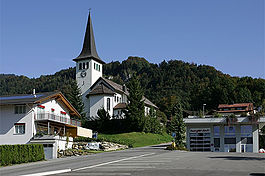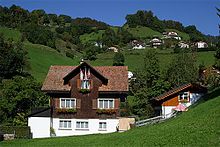Illgau | |
|---|---|
 | |
| Coordinates: 46°59′N 8°43′E / 46.983°N 8.717°E | |
| Country | Switzerland |
| Canton | Schwyz |
| District | Schwyz |
| Area | |
| • Total | 10.9 km2 (4.2 sq mi) |
| Elevation | 807 m (2,648 ft) |
| Population (31 December 2018)
[2] | |
| • Total | 802 |
| • Density | 74/km2 (190/sq mi) |
| Time zone | UTC+01:00 ( Central European Time) |
| • Summer ( DST) | UTC+02:00 ( Central European Summer Time) |
| Postal code(s) | 6434 |
| SFOS number | 1363 |
| ISO 3166 code | CH-SZ |
| Surrounded by | Muotathal, Oberiberg, Schwyz |
| Website |
www SFSO statistics |
Illgau is a municipality in Schwyz District in the canton of Schwyz in Switzerland.
History
Illgau is first mentioned in 1370 as Ilgoe. [3]
Geography


Illgau has an area, as of 2006 [update], of 10.9 km2 (4.2 sq mi). Of this area, 62% is used for agricultural purposes, while 31.1% is forested. Of the rest of the land, 2.9% is settled (buildings or roads) and the remainder (4%) is non-productive (rivers, glaciers or mountains). [4]
It consists of the village sections of Illgau, Vorder Oberberg and Hinter Oberberg as well as scattered farm houses. All of the farm houses, up to about the 1,300 m (4,300 ft) level are occupied throughout the year.
Demographics
Illgau has a population (as of 31 December 2020) of 795. [5] As of 2007 [update], 1.6% of the population was made up of foreign nationals. [6] Over the last 10 years the population has grown at a rate of 7%. Most of the population (as of 2000 [update]) speaks German (99.2%), with Albanian being second most common ( 0.3%) and Russian being third ( 0.3%). [4]
As of 2000 [update] the gender distribution of the population was 50.8% male and 49.2% female. The age distribution, as of 2008 [update], in Illgau is; 242 people or 33.6% of the population is between 0 and 19. 241 people or 33.4% are 20 to 39, and 166 people or 23.0% are 40 to 64. The senior population distribution is 45 people or 6.2% are 65 to 74. There are 19 people or 2.6% who are 70 to 79 and 8 people or 1.11% of the population who are over 80. [6]

As of 2000 [update] there are 248 households, of which 71 households (or about 28.6%) contain only a single individual. 31 or about 12.5% are large households, with at least five members. [6]
In the 2007 election the most popular party was the SVP which received 53.9% of the vote. The next three most popular parties were the CVP (36.4%), the SPS (5.5%) and the FDP (1.7%). [4]
The entire Swiss population is generally well educated. In Illgau about 55.2% of the population (between age 25-64) have completed either non-mandatory upper secondary education or additional higher education (either university or a Fachhochschule). [4]
Illgau has an unemployment rate of 0.96%. As of 2005 [update], there were 70 people employed in the primary economic sector and about 28 businesses involved in this sector. 63 people are employed in the secondary sector and there are 8 businesses in this sector. 71 people are employed in the tertiary sector, with 14 businesses in this sector. [4]
From the 2000 census [update], 698 or 96.8% are Roman Catholic, while less than 5 people belonged to the Swiss Reformed Church. There are 6 (or about 0.83% of the population) who are Islamic. 9 (or about 1.25% of the population) belong to no church, are agnostic or atheist, and 6 individuals (or about 0.83% of the population) did not answer the question. [6]
The historical population is given in the following table: [3]
| year | population |
|---|---|
| 1850 | 246 |
| 1900 | 270 |
| 1950 | 390 |
| 1990 | 633 |
| 2000 | 721 |
| 2005 | 776 |
| 2007 | 792 |
References
- ^ a b "Arealstatistik Standard - Gemeinden nach 4 Hauptbereichen". Federal Statistical Office. Retrieved 13 January 2019.
- ^ "Ständige Wohnbevölkerung nach Staatsangehörigkeitskategorie Geschlecht und Gemeinde; Provisorische Jahresergebnisse; 2018". Federal Statistical Office. 9 April 2019. Retrieved 11 April 2019.
- ^ a b Illgau in German, French and Italian in the online Historical Dictionary of Switzerland.
- ^ a b c d e Swiss Federal Statistical Office Archived 2016-01-05 at the Wayback Machine accessed 28-Aug-2009
- ^ "Ständige und nichtständige Wohnbevölkerung nach institutionellen Gliederungen, Geburtsort und Staatsangehörigkeit". bfs.admin.ch (in German). Swiss Federal Statistical Office - STAT-TAB. 31 December 2020. Retrieved 21 September 2021.
- ^ a b c d Canton Schwyz Statistics Archived 2011-06-09 at the Wayback Machine (in German) accessed 27 August 2009
External links
- Illgau in German, French and Italian in the online Historical Dictionary of Switzerland.
Illgau | |
|---|---|
 | |
| Coordinates: 46°59′N 8°43′E / 46.983°N 8.717°E | |
| Country | Switzerland |
| Canton | Schwyz |
| District | Schwyz |
| Area | |
| • Total | 10.9 km2 (4.2 sq mi) |
| Elevation | 807 m (2,648 ft) |
| Population (31 December 2018)
[2] | |
| • Total | 802 |
| • Density | 74/km2 (190/sq mi) |
| Time zone | UTC+01:00 ( Central European Time) |
| • Summer ( DST) | UTC+02:00 ( Central European Summer Time) |
| Postal code(s) | 6434 |
| SFOS number | 1363 |
| ISO 3166 code | CH-SZ |
| Surrounded by | Muotathal, Oberiberg, Schwyz |
| Website |
www SFSO statistics |
Illgau is a municipality in Schwyz District in the canton of Schwyz in Switzerland.
History
Illgau is first mentioned in 1370 as Ilgoe. [3]
Geography


Illgau has an area, as of 2006 [update], of 10.9 km2 (4.2 sq mi). Of this area, 62% is used for agricultural purposes, while 31.1% is forested. Of the rest of the land, 2.9% is settled (buildings or roads) and the remainder (4%) is non-productive (rivers, glaciers or mountains). [4]
It consists of the village sections of Illgau, Vorder Oberberg and Hinter Oberberg as well as scattered farm houses. All of the farm houses, up to about the 1,300 m (4,300 ft) level are occupied throughout the year.
Demographics
Illgau has a population (as of 31 December 2020) of 795. [5] As of 2007 [update], 1.6% of the population was made up of foreign nationals. [6] Over the last 10 years the population has grown at a rate of 7%. Most of the population (as of 2000 [update]) speaks German (99.2%), with Albanian being second most common ( 0.3%) and Russian being third ( 0.3%). [4]
As of 2000 [update] the gender distribution of the population was 50.8% male and 49.2% female. The age distribution, as of 2008 [update], in Illgau is; 242 people or 33.6% of the population is between 0 and 19. 241 people or 33.4% are 20 to 39, and 166 people or 23.0% are 40 to 64. The senior population distribution is 45 people or 6.2% are 65 to 74. There are 19 people or 2.6% who are 70 to 79 and 8 people or 1.11% of the population who are over 80. [6]

As of 2000 [update] there are 248 households, of which 71 households (or about 28.6%) contain only a single individual. 31 or about 12.5% are large households, with at least five members. [6]
In the 2007 election the most popular party was the SVP which received 53.9% of the vote. The next three most popular parties were the CVP (36.4%), the SPS (5.5%) and the FDP (1.7%). [4]
The entire Swiss population is generally well educated. In Illgau about 55.2% of the population (between age 25-64) have completed either non-mandatory upper secondary education or additional higher education (either university or a Fachhochschule). [4]
Illgau has an unemployment rate of 0.96%. As of 2005 [update], there were 70 people employed in the primary economic sector and about 28 businesses involved in this sector. 63 people are employed in the secondary sector and there are 8 businesses in this sector. 71 people are employed in the tertiary sector, with 14 businesses in this sector. [4]
From the 2000 census [update], 698 or 96.8% are Roman Catholic, while less than 5 people belonged to the Swiss Reformed Church. There are 6 (or about 0.83% of the population) who are Islamic. 9 (or about 1.25% of the population) belong to no church, are agnostic or atheist, and 6 individuals (or about 0.83% of the population) did not answer the question. [6]
The historical population is given in the following table: [3]
| year | population |
|---|---|
| 1850 | 246 |
| 1900 | 270 |
| 1950 | 390 |
| 1990 | 633 |
| 2000 | 721 |
| 2005 | 776 |
| 2007 | 792 |
References
- ^ a b "Arealstatistik Standard - Gemeinden nach 4 Hauptbereichen". Federal Statistical Office. Retrieved 13 January 2019.
- ^ "Ständige Wohnbevölkerung nach Staatsangehörigkeitskategorie Geschlecht und Gemeinde; Provisorische Jahresergebnisse; 2018". Federal Statistical Office. 9 April 2019. Retrieved 11 April 2019.
- ^ a b Illgau in German, French and Italian in the online Historical Dictionary of Switzerland.
- ^ a b c d e Swiss Federal Statistical Office Archived 2016-01-05 at the Wayback Machine accessed 28-Aug-2009
- ^ "Ständige und nichtständige Wohnbevölkerung nach institutionellen Gliederungen, Geburtsort und Staatsangehörigkeit". bfs.admin.ch (in German). Swiss Federal Statistical Office - STAT-TAB. 31 December 2020. Retrieved 21 September 2021.
- ^ a b c d Canton Schwyz Statistics Archived 2011-06-09 at the Wayback Machine (in German) accessed 27 August 2009
External links
- Illgau in German, French and Italian in the online Historical Dictionary of Switzerland.


